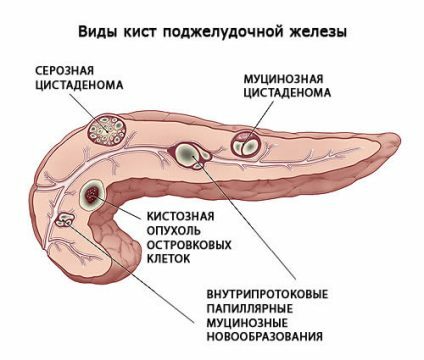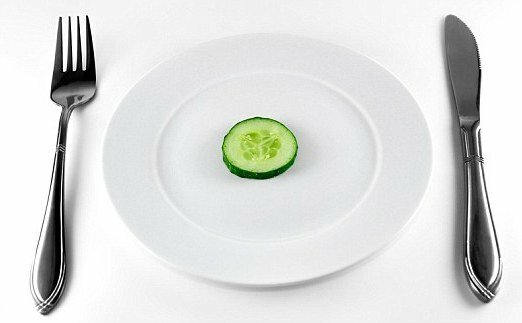The appearance in the cavity of the internal organs of any large-scale formation provokes a disruption in their functioning. Cysts of the pancreas are no exception.
A cyst, called a bubble or sac in the common people, is a pathological cavity( formation) that grows in the tissues of the pancreas. This cavity contains a liquid with enzymatic substances. It negatively affects the gland tissue, if there is a rupture of the sacs.
As the cavity grows, pancreatic distress also increases, as its tissues are destroyed, which leads to a decrease in the secretory function. The human body does not receive the enzymes and hormones necessary for its normal functioning.
The quality of human life can be significantly improved if in time to diagnose pathology and take measures to eliminate it.
What dangers poses

In modern life, this disease is considered quite common not only among men. Representatives of the fair sex, it is also amazing. Many people are thoughtless about predicting the possible formation of cavities on the pancreas iron. At the same time, nobody is immune from this pathology, and the disease itself is quite dangerous.
At all times, doctors have stated that the disease is better prevented than treated later. If education has acquired a malignant character, metastases may also spread to other organs. In this case, doctors put a disappointing prognosis, and the sick person will be quite difficult to help.
If the tumor has not yet become malignant, you do not need to rejoice ahead of time. It is capable in the shortest possible time to reach large sizes, in which the slightest blow or awkward movement will provoke its break. In this case, it is extremely important for a sick person to provide qualified medical care. If this is not done, the occurrence of sepsis or peritonitis is not ruled out, which often leads to death.
Predisposing factors and causes of
In the matter of formation of formations, human age is not the underlying cause. Pathology can manifest at any age.
The most common causes:
- hereditary defects,
- helminth infection,
- exacerbation of pancreatitis,
- overlap and deterioration of the inferior duct,
- trauma, organ surgeries,
- chronic or acute organ disease,
- presence on the tumor organ.

Causes that may affect the formation of pathology:
- bad habits, manifested in addiction to strong alcoholic beverages,
- malnutrition,
- diabetes, belonging to the second type.
If in a person's life there is at least one circumstance given in the form of the causes of pancreatic cysts, you need to think about your health and turn to a specialist.
General symptoms of
If the formation is small, the presence of the disease is poorly manifested. A person either does not worry about anything, or he feels a slight discomfort in the stomach and intestines.
When the formation is huge, the symptoms of the disease are strongly pronounced. On the presence of pathology testify:
- Aching or paroxysmal pain under the hypochondrium( both left and right).
- In the area of the abdominal cavity appears a seal( it is easy to feel).
- In the upper part of the abdomen, there are felt violent pains that give off under the shoulder blade and turn into pain of shingles.
- A person has a digestive disorder and an unreasonable weight loss.
- There is a feeling of nausea, vomiting, appetite decreases.
The appearance of certain symptoms depends on the stage at which the disease occurs. Depending on the size of the education, whether it is infected or not, the intensity of pain will depend.
Symptoms of Complication

If the disease is in a neglected form and has grown to a huge size, the formation begins to squeeze and dislodge the adjacent organs, which is also accompanied by pain. The most severe pain is felt when the tumor presses on the celiac neural plexus. When neighboring organs are pinched, the outflow into the duodenum of bile is disturbed. This leads to the development of jaundice, the digestive process is violated, a strong pain syndrome, a color of urine changes, acquiring a darker shade, the stool becomes light.
When the cyst is infected, the pain is accompanied by symptoms such as:
- chills,
- body temperature increase,
- general weakness of the body.
Having reached a large size, the formation can burst. At the same time, the liquid contained in it penetrates into the abdominal cavity, causing bleeding. If this happens, the symptoms will be pronounced:
- sensation of severe pain,
- weakness,
- cold sweat,
- loss of consciousness.
If you have any of the above symptoms, it is advisable to contact the medical institution as early as possible. Doctors will conduct an appropriate examination and establish the fact of the presence or absence of pathology. Avoid unpleasant consequences and complications can only be if the treatment is timely.
Conservative treatment methods
Treatment is not always based on the operation. You can initially try conservative methods. If you can not achieve the desired result, resort to other ways of removing education.

Treatment of a cyst without surgery is possible under the following conditions:
- The volume of growths does not exceed 20 mm.
- The education is single and has clear limitations.
- There are no pronounced painful sensations.
- No mechanical jaundice.
For 72 hours the patient should follow a hunger diet. The further diet should be sparing: without fried, fatty and salty foods. This will stop the process of destruction of the gland tissues, since by gentle nutrition the enzyme secretion of the organ decreases. Also for 7 days you need to adhere to bed rest, you can not smoke and drink alcohol.
Patient is prescribed a course of antibiotics( from a series of cephalosporins and tetracyclines) to avoid the process of suppuration of the cyst and prevent the penetration of bacterial infection.
Also carried out enzyme therapy. CREON and Pancreatin preparations are used. Therapy improves digestion of fat and carbohydrates by the esophagus.
Such treatment lasts a month. If it does not lead to the desired result, the patient is prescribed an operation.
Surgical intervention
Such treatment should be carried out in specialized medical centers under the supervision of an ultrasound machine. This reduces the risk that any complications will occur.
Treatment with traditional( surgical) methods implies such procedures as:
- Cystoenterostomy - the cavity of formation is opened for the purpose of emptying( after the procedure the cavity is treated with 96% ethyl alcohol, then the intestinal walls are sewn).
- Resection - the formation is removed.
- Draining - the procedure allows minimally injuring the patient's organ.
During the postoperative period, the patient must follow a diet, eliminating salted, fatty and fried foods from the diet. He is prescribed a course of drugs that include enzymes of the pancreas. The patient is not allowed to physically strain for two months after the operation. He must visit the medical institution every six months to monitor the condition.



